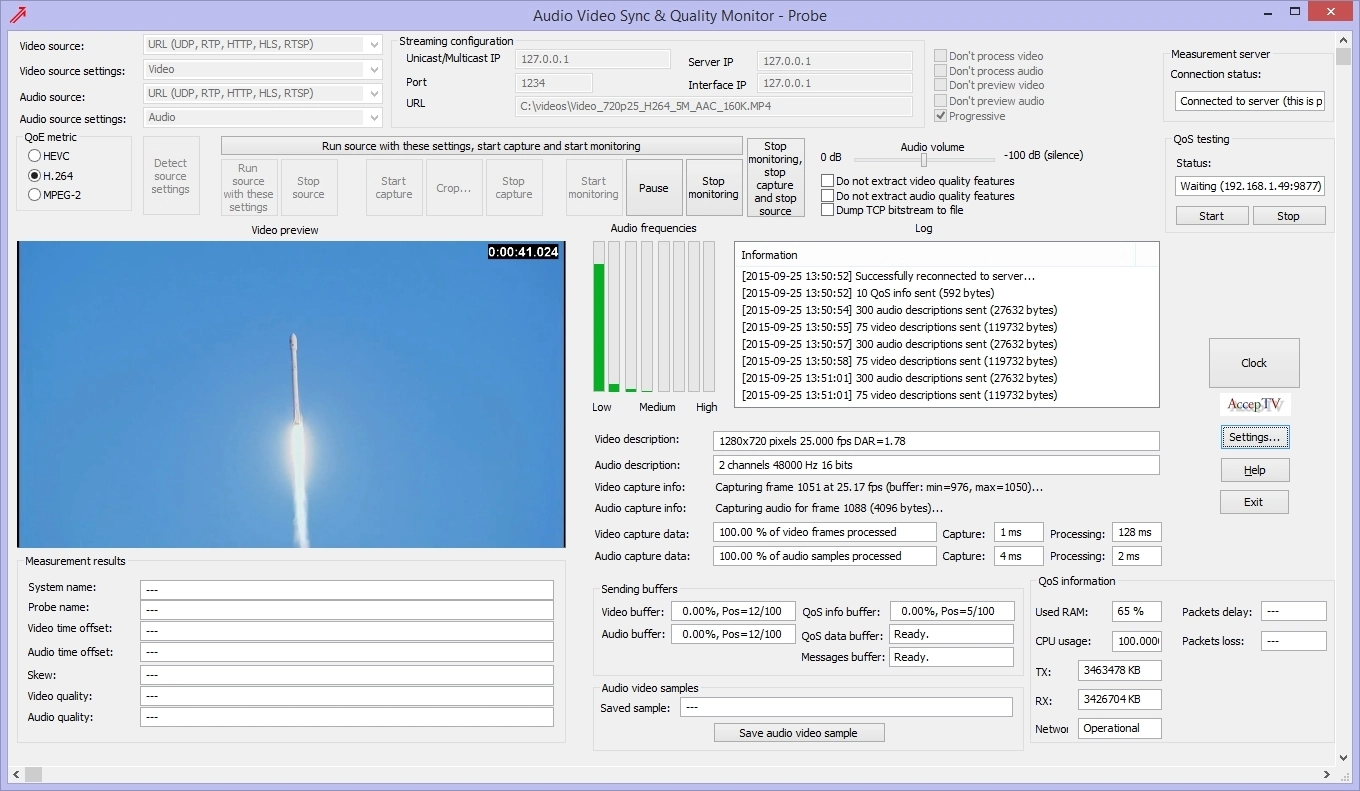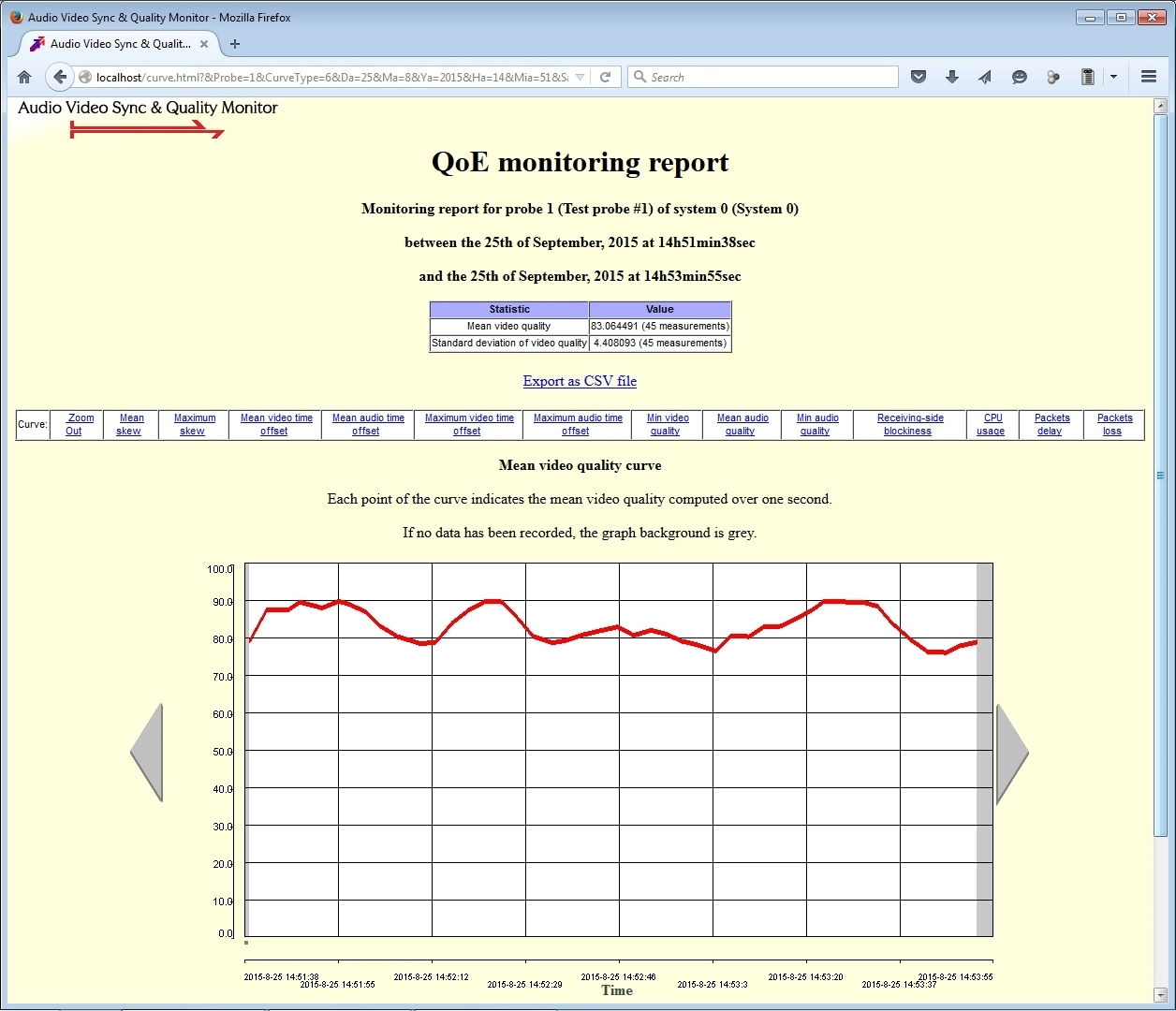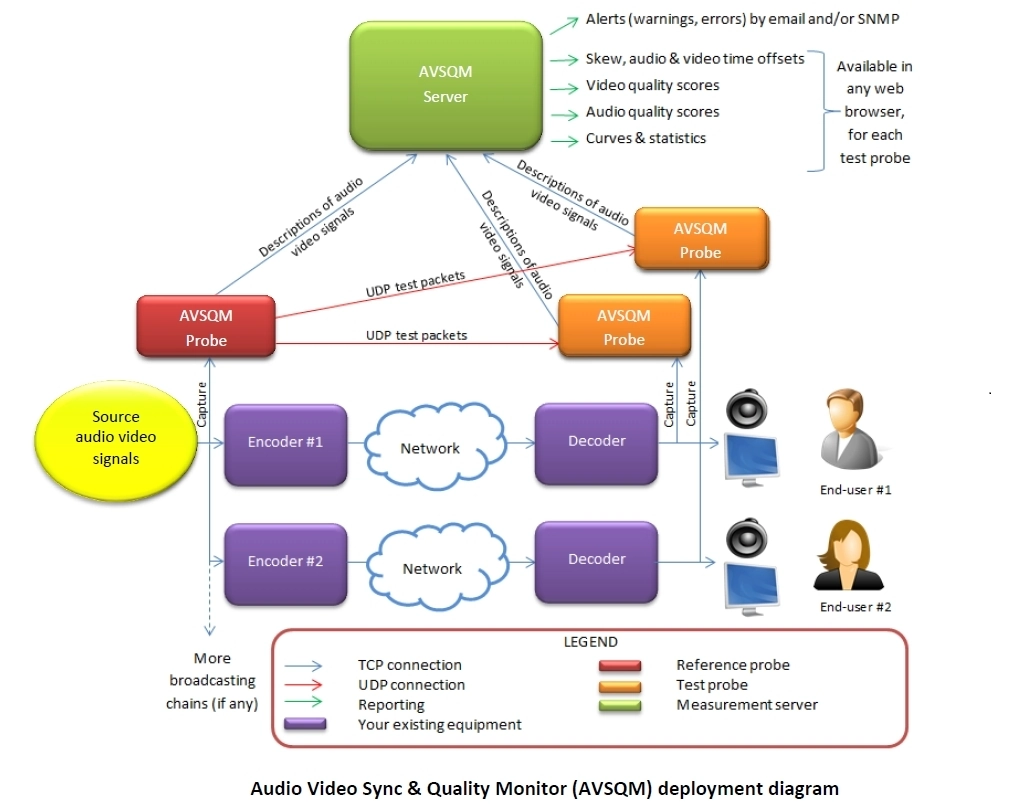Audio Video Sync & Quality Monitor
QoE and QoS measurement/monitoring for audio/video transmissions
Audio Video Sync & Quality Monitor (AVSQM) is a powerful and scalable solution which enables to measure and monitor both QoE (Quality of Experience) and QoS (Quality of Service) for audio/video transmissions, especially for TV channels broadcasting.
QoE (Quality of Experience) is measured by the following indicators (KPI: Key Performance Indicators):
- Perceived video quality (MOS value and indicators like blockiness, blur, etc.)
- Perceived audio quality (MOS value and indicators like bandwidth, HF presence, etc.)
- Video delay
- Audio delay
- Skew (amount of misalignment between audio and video)
QoS (Quality of Service) is measured by the following indicators (KPI):
- Transmission-related parameters: packets delay, jitter, reordering, corruption, etc.
- Machine-related parameters: CPU usage, RAM usage, etc.
AVSQM includes three different video quality metrics, dedicated to three different codecs:
- MPEG-2
- H.264
- HEVC
AVSQM enables to:
- Compare the different versions (supplied by different Internet Service Providers or Telecom Operators) of a TV channel
- Monitor audio and video broadcast over different networks
- Benchmark audio and video equipment
- Check non-regression after audio/video equipment firmware update
- Receive alerts when problems happen
Overview
AVSQM is a solution containing two applications:
- The probe (which will run on several machines)
- The measurement server (which will generally run on one machine only, but which can run on several machines if needed)
Each probe can process one audio signal and/or one audio video signal:
- First, the probe captures or decodes the signals from audio video files, from IP streaming (in UDP, RTP, HTTP, HTTP Live Streaming, RTSP or RTMP), from capture cards/devices or from desktop capture
- Then the probe computes short descriptions of short portions of the audio and video signals
- Then the probe sends these short audio/video descriptions to the measurement server
In order to monitor one audio/video communication, at least two probes must be used:
- A reference probe which captures the reference audio/video signals (typically: at the output of the TV studio, before encoding)
- A test probe which captures the audio/video signals under test
In parallel, probes measure the health parameters of their local machine (CPU usage, RAM usage, etc.). Probes can also exchange test packets between them in order to measure transmission-related QoS parameters (packets loss, packets delay, jitter, reordering, corruption).
Measurement server
The measurement server works like this:
- First, it receives short audio/video descriptions from one or several probes
- For each test probe (when its reference probe is also connected), the measurement servers computes the QoE and QoS parameters (KPIs: Key Performance Indicators)
- If some measured values are beyond user-defined thresholds, the measurement server triggers alerts
- The measurement server saves all the measured values
- At last, the measurement server has a web interface (available in your favorite web browser) which enables to remotely monitor communications and to browse past measures (and get curves and statistics)
Starting Audio Video Sync & Quality Monitor
To use AVSQM, you must choose the QoE metric which corresponds to the audio/video signals you want to process. AVSQM includes three different video quality metrics, each one being designed for a particular codec:
- MPEG-2
- H.264
- HEVC
Then you only have to:
- select the source: file, IP streaming, capture card/device or desktop capture
- select the source settings (if needed): video camera resolution, particular stream, audio sampling rate, etc.
- start capturing
- if needed, define how to crop the video to select only a precise area
- start monitoring
Then the probe will process audio and video signals, transform them into short descriptions and send these descriptions to the measurement server (with automatic reconnection if the connection gets lost).
All along these steps, the rich interface of AVSQM indicates the detected parameters: detected devices, detected settings, detected resolution, detected audio sampling rate, etc. It also displays the levels of the internal buffers and a log window concerning the connection with the measurement server.
Results
The measurement server computes QoE and QoS parameters. And thanks to its web interface, the measurement server enables to:
- Generate statistics and curves in real time
- Generate statistics and curves between two user-chosen dates and times
- Export CSV reports
The measurement server can also trigger alerts when problems happen (when a QoE or QoS parameter goes beyond user-defined limits for a user-defined duration).
Flexible and scalable
AVSQM is scalable. Indeed, it supports from 1 to 1000 probes (for more: contact us). And AVSQM supports from 1 to 1000 users (for more: contact us), each user being able to define thresholds and durations to trigger alerts (two levels of alerts: warnings and errors).
AVSQM is also flexible, thanks to:
- its modular architecture, based on probes and measurement servers
- its configuration files in text format (which can be edited through AVSQM's GUI or using a text editor)
- the possibility to use it from command line, with parameters
- the export of measured data through CSV reports
Conclusion
Audio Video Sync & Quality Monitor is a powerful and flexible tool to measure and monitor both QoE and QoS for audio/video transmissions.
Thanks to the various types of inputs it supports and thanks to its modular architecture based on different types of probes and servers, AVSQM can be easily adapted to your audio/video infrastructure.
Therefore:
- to check and monitor QoE and QoS in audio/video transmissions
- to receive alerts when problems happen
- and to browse past measurements
...just ask for an evaluation version of Audio Video Sync & Quality Monitor now!






